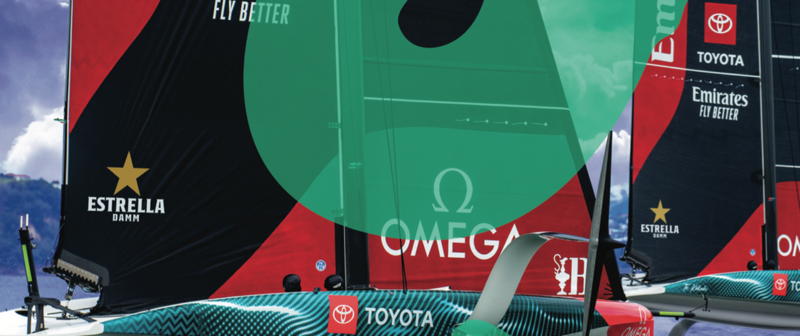
2028 America’s Cup To Be Held Entirely in Virtual Reality
After a recent meeting at the New York Yacht Club, the current America’s Cup teams revealed that the next America’s Cup would be held entirely in a virtual environment. “It only makes sense,” said Emirates Team New Zealand syndicate head Grant Dalton, who continued, “95% of the time between America’s Cup events is done with computer simulators and I think it’s really the right time to just eliminate the last 5% that is done on the water. Very few of the people on the boats are actually sailors, and as everyone knows, it’s really all about who can design the fastest boat.”
The meeting was initially called to debate a proposal from New York Yacht Club staff commodores to return the Cup to IACC boats or even 12 meters, since so many club members have never understood how boats can go around a race course and never go downwind. That proposal quickly went off course when a younger member reminded the gathered group that the “future is foiling.” It was at this point that INEOS Team UK CEO Sir Ben Ainslie spoke up, saying, “If I really think about it, ever since I stopped racing Finns the majority of my time has been involved in design and HR meetings. I don’t really spend time on the water anymore. The primary thing we’re doing in our design meetings is to optimize all the design variables and eliminate as many of the things we can’t control. When it comes down to it, one of the biggest, hard-to-control variables is people.”

That was when Dalton chimed in, saying, “The people component has always been a huge headache for me, which is what got me to thinking about moving to a virtual America’s Cup.” As he stated, “People have been my number-one problem. I’ve had the entire nation of New Zealand against me since I moved the Cup to Barcelona. If we do the event virtually we could essentially hold the Cup anywhere without having to build infrastructure. If you all think about it, we could please all the Cup sponsors by holding the Louis Vuitton Cup in a rotating series of races that are held in each syndicate nation’s chosen port without having to bring boats there. Then I could hold the Cup final out of Viaduct Basin, though we wouldn’t have to deal with the awkward, out-of-sync-with-the-world seasons and time zone.”
After that bold statement, there was a dramatic shift in tone in the room as syndicate leaders thought of the many pain points that would be relieved by not actually having to build a boat, ship it around the world, hire a few sailors, and put human life at risk on the water. Terry Hutchinson spoke up. saying, “If our crash in New Zealand had happened in the virtual world, the repairs would have taken far less time and we could have continued in the series.” Alinghi Red Bull team chief Ernesto Bertarelli chimed in, saying, “I really could satisfy the Deed of Trust by creating a virtual ‘arm of the ocean’ in Switzerland so we could host in our home country. I don’t have time to wait for climate change to do it for me.” One of the design engineers in attendance spoke up, suggesting, “If we eliminate the constraints of hydrodynamics we could probably get these boats to go much faster than 60 knots, so the average race could fit comfortably into the average viewer’s scroll through their Instagram reels.” The French Team Orient Express suggested that it would also be much easier to have gender parity since physical strength would no longer be a factor.

It was then that Ainslie was reminded of everyone’s commitment to sustainability and suggested that by going virtual, INEOS Team UK could dramatically lower its carbon footprint. He said, “By not having to build a boat, hire sailors and ship it all over the world we’d lower our carbon footprint and lower our costs so we’d have a lot more flexibility when selecting sponsors. Additionally, we’d be able to eliminate all the spying and design-secrecy aspects, since we’d never have to reveal an actual boat.” As the assembled team representatives started to relax and imagine the reduced strain on themselves as they let go of dealing with the physical world and all the HR issues, the conversation turned to whether this would all be done with Apple Vision Pro goggles and other elements of managing the technology, game consoles and digital dashboards that would help monetize the eyeballs. They could create true stadium sailing without the constraints of shallow water, wind shadows from buildings and uneven currents across the course.
A few syndicate heads slipped out of the room to get a head start recruiting gamers from the professional video game world of League of Legends and Fortnite, while Prada and LVMH started designing apparel for the avatars of the virtual sailors who could purchase virtual boats to race alongside the America’s Cup teams. Moët & Chandon was already looking into home delivery for champagne. The brands could now see value in their sponsorship with the rapid expansion of participation in sailing, since expense and seasickness would no longer keep the masses away.

After one of the wait staff, who spends his free time volunteering at the Sail Newport community sailing center, leaked the tone of the conversation, a sailor at the club bar said, “I’m not surprised. It already feels that way since the digital graphics and animation make me feel like I’m in the office doing a global screen share on Zoom rather than watching a sailing competition. I really get enough screen time.” Another chimed in, “I’m never quite sure what’s real anymore. With all the AI animation and enhanced video effects that come through screens, I find I really need to go down to my boat, haul up some sails, and taste the salt water in the spray to make sure I’m still on Planet Earth.”
While the AC meeting was breaking up and the representatives were rapidly texting secure messages over their VPNs, the two sailors decided to shut off their iPhones and head out for a quiet sail with the local fleet of 1962 Shields one designs. Several other fleet members were out, and they had some casual, fun practice races by rounding a physical buoy and hoisting spinnakers while watching the puffs on the water, the compass, and telltales on the shrouds to keep an eye on the subtle shifts in the breeze.
As today is April 1, we’re going to take a pause before we believe the story we just shared.
